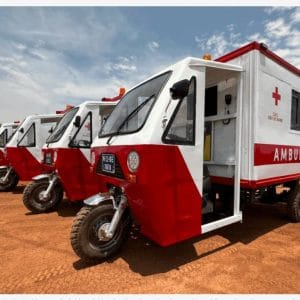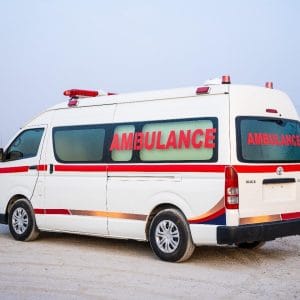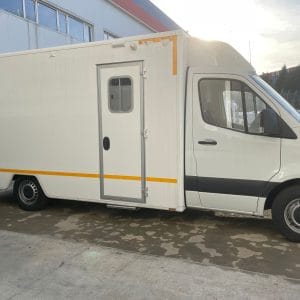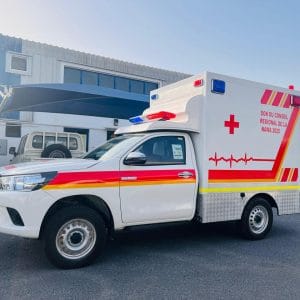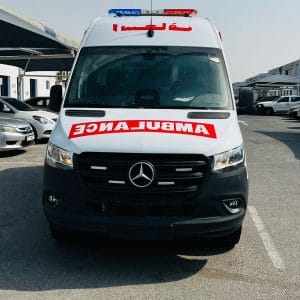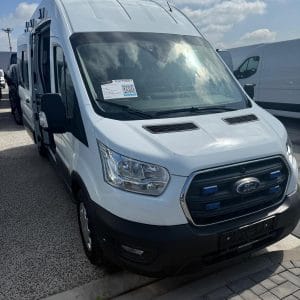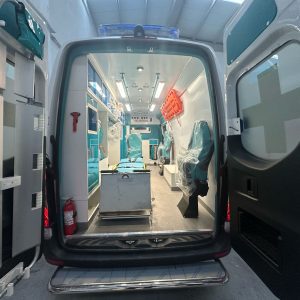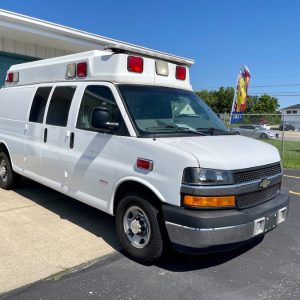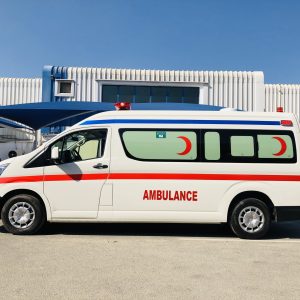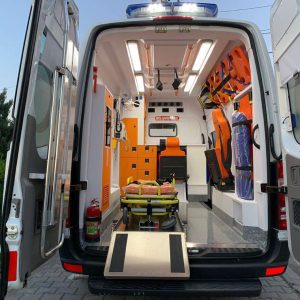1. Introduction to Toyota Ambulance
Toyota Ambulance Specifications; The Toyota is a highly versatile automobile, being modified for numerous uses other than the usual usage for passengers. From primarily sedans and trucks, the Toyota has been modified to cater to police, transport of goods and services, as fire trucks, for military use, and as ambulances. In addition, the Toyota has been modified, and because it is reliable, the cost of maintenance is lower compared to vehicles made specifically for such specialized uses. The Toyota addresses the needs of many developing countries where service needs are enormous, but budgets specifically designated to acquire such vehicles are limited. With maintenance, the vehicle can survive over long periods of usage.
The Toyota Land Cruiser model is commonly used as ambulances. The Land Cruiser can be the station wagon and other variations, which are costly. However, the use of the Toyota Land Cruiser as a van is receiving widespread attention. There are other vehicle manufacturers who also now manufacture vans with a higher roof, some also with the windows at the rear of the van with custom-made ambulances. The van for use as the ambulance is a relatively simple model in comparison to a station wagon. The use of a van motor vehicle for use as an ambulance is not limited to the more developed countries. Being relatively simple, these Toyota Land Cruiser vans can and are assembled in many countries.
1.1. History and Evolution of Toyota Ambulances
The ambulance is a form of a vehicle specially designed to care for sick people before they get to the hospital. To meet all emergency situations on the road, the Toyota Motor Company has been adding safety and durability to its vehicles. This phase reports a comprehensive evaluation of the Toyota ambulance characteristics such as safety features, emergency features, lifespan, stability, seating plan, comfort, permitted flexibility, preventive maintenance, and ergonomics. Twenty-seven Toyota model ambulances were studied. However, model 40 occurred in only 1% while model 47 was in 4%. This is followed by model 50 (16%) and model 20 with 22%. Then model 44 takes the lead with 37%, and models 44 and 47 record 40% and 30%, respectively. In 1979, model 40 was providing the most demand in Saitama and Tokyo Prefecture, and model 50 at the Osaka ambulance center. Model 47 was only used in the Mie Prefecture for 23% of the first.
Toyota Tsusho Corporation, a branch of the Toyota group, designed and manufactured ambulances in 1960. The purpose was to help the injured at traffic accident scenes during the Japan Olympics and Paralympics. In the same year, Honda Tadakatsu constructed a concrete building to park ambulances and set up emergency medical equipment route charts. To speed up the dispatching of emergency vehicles, new fire and ambulance stations are constructed across the country. Many EMS development plans have been implemented in our country. This has produced the best results for our physicians. For example, in 1960, the death incidence rate of traffic accident injuries was 20% in Tokyo. However, the utilization rate has dropped to 9% lately. The Toyota Motor Company also contributed to the effort to save people’s lives via speedy delivery. It launched the first Toyota ambulance on June 30th, 1950. It was an original prototype. Its fuel consumption rate is low, and it can achieve superior riding quality. As for the security system, it was powered by a 105 hp engine. It complies with the ambulance specifications and is the last option. The Toyota Motor Company has established a reputation for producing durable motorcars.
2. Design and Features Toyota Ambulance
The ambulance body is designed with special consideration of the EMS functions. The design starts with consideration of ensuring that the patient is properly positioned and fitted in the relative center of the vehicle body so that space for monitoring and treatment is made available all around. Since there is also a possibility of patients being treated or monitored in a lying position, as a standard feature, the internal length is set to be larger than 2 m when the vehicle is fully closed and the width to accommodate an average adult, and abundant space is made available both inside and out. A specifically designed feature is the flat floor and the lack of bunks.
In an ambulance, the occupant value is different from that of the private car or the bus since lifesaving is the function. It is equipped with windows for difficult ventilation, and all side seating supports the unbelted sitting position of an EMS member. It boasts a high body rigidity with support already in place to structure a smooth ride even in an emergency. Most of the equipment frequently used by the anesthesiologist and the emergency physician occupies the space near the door for ultra-quick access. The choice of light and right location of the apparatus as well as lighting is especially important so that the EMS members can work in the suitable day and night.
2.1. Exterior Design
Exterior toys need to be designed in order to affect the occupant inside to have a feeling of amazement and excitement so that the goal of moving the person in an emergency can be achieved. The ambulance design will look like a superhero who will help them and make them amazed by the advanced technology in the vehicle. External materials aim to demonstrate the strength and technological ability of types to provide the best service and quality. A blue color scheme was chosen as a standard color for ambulances because it exhibits a strong image that is consistent with governmental enterprises and represents the dignity of an emergency vehicle and humanitarian color. The high eye-point 360-degree visibility and the streamlined shape provide a smart and friendly look and can move smoothly and efficiently with minimal air resistance. In addition, both the front and rear of the vehicle emphasize a move with an advanced performance design by employing trapezoid-shaped headlamps, brake lamps, and high-position stop lamps.
More importantly, the latest technology equipped with the leading company-trained specialist treatment and transportation vehicle makes them feel safest. The strong, distinctive, and eye-catching design of an advanced and innovative emergency vehicle will help it fit an essential image among different types of vehicles on the road. The front overhang is reduced to accommodate a short overhang and optimal wheel position for optimized wheel torque without compromise, as well as a generous interior. The vanguard harp edge design with daytime running lights and silver bumper black bezel ventilation exudes a sense of speed, excitement, and strength. The limb leaves are a bright and affordable archive that gives a strong and professional image. The side seal automatic rescue wheel lamp reflects the cutting-edge and no-nonsense effect details. The 360-degree exterior panic lens flame reinforcement effect represents the strength, power, and security of the interior design of the ambulance.
2.2. Interior Layout and Features
The interior of the ambulance will have been engineered to withstand rough handling, with flameproof finishes on the ceiling and moisture-resistant materials in all the compartments. Recent technological advances are reflected, for example, in a diagnostic unit providing the ability for the ambulance’s various components to be checked. A batch of automotive textiles guarantees reliability, durability, and flameproof properties. While the ambulance as a whole includes robust gear for responding efficiently and speedily to the demands of non-standard movement due to its non-uniform weight load, conditions in the front passengers’ area of the interior realize the coexistence of oppositely operating forces, minimizing the various stresses in critical areas and ensuring passivity for occupants. With respect to safety, the number of rear crew members being transported will be significant; hence, the innovative “seriously injured bar” in the middle of the stretcher will stabilize them, reducing transport times safely and reducing stress.
3. Medical Equipment and Technology Toyota Ambulance
Medical Equipment and Technology: Inequity in medical services and health resources is still a serious problem, especially in developing countries such as Indonesia. One of the inadequate health infrastructures is a transportation facility to access health services. Medical transportation needs to have a standard to operate in any health situation. An ambulance is a complete health facility in the transportation means used for moving patients whose condition and illness must be attended to. It also functions to protect and provide medical care to patients on their way to a hospital. The ambulance service unit, in delivering ambulance service, must be a medical facility and run in accordance with the minimum standards of ambulance facilities.
The function of a medical institution can be performed by using the necessary medical devices, such as ECG, nebulizers, mechanical ventilators, medical refrigerators, antidotes, placental extract, analgesic liquid, sterilizing fluid, first aid, and emergency medical packages. An ambulance is a complete health facility in the transportation means used for moving patients whose condition and illness must be handled. The equipment in the ambulance is equipped with medical devices to provide first aid according to the severity level of the patient’s health condition up to the transportation process to the hospital.
3.1. Standard Equipment Toyota Ambulance
The standard equipment provided by the manufacturer is very important to the specified use of the vehicle. The structure of the vehicle should be designed and equipped according to the patient conditions and emergency care that will be performed by the emergency care team. This ensures that the driver can fully exercise their function and provide the necessary technological support. Each ambulance model should have the necessary and sufficient equipment for the proper operation and care of the patients. Thus, standard equipment is defined as factory equipment that distinguishes it from a motor home. This includes all the available physical elements of the vehicle that are required to perform the functions for which it is intended. Based on the importance of the project being done for use in emergency situations, the team should conduct a detailed survey of all physical items that the vehicle should contain as standard. The minimum requirement is having a space for the stretcher, a platform to support and service the passenger, and a workbench with positions for medical equipment and medical teams, including a medical kit, stethoscopes, electrocardiograph, defibrillator, oxygen therapy equipment, among other elements. With such data, negotiations with the manufacturer for standardized equipment should be easier. Listed below are the standard equipment for which approval was granted by the Quality Management System. Safety: Airbags; body reinforcements; carbon pad radiator core; child protection locks; child locks; immobilizer; and inertia with pretensioners for the front seats. Comfort and Convenience: Adjustable front seat belts with 3 points; adjustable steering column; central air conditioner; central lock with remote control; electric windows for the driver; door glass tinted; electric with mode; driver’s seat with height adjustment; mirror in the sun visor for driving and passenger; illuminated sun visor for driver and passenger; antifog; mirror light for the front passenger; antifog; retractable mirror courtesy on the driver’s side; courtesy light on the front passenger’s side; electric, internal and external adjustment of the rearview mirror; and keyless entry. Functional and Leisure: Electro-luminous gauge in the dashboard; electronic fuel gauge; multi-functional audio; and USB input.
3.2. Optional Upgrades and Technologies Toyota Ambulance
This section calls attention to some specific aspects and capabilities of the Toyota HiAce that are not outlined in the basic station wagon configuration offered earlier. Essentially, these sections provide information on the available packages and latest features that are worth considering as additional options for the vehicle conversion unit. It is up to the preference of the ambulance selection committee or customer to decide if these are really necessary. We specifically consider a known and appreciated feature within the range of Toyota HiAce buses, the Toyota Package Comfort Buses and Minibuses. The available technology in such Toyota minibuses could guarantee high safety systems within a high and deluxe partitioned passenger compartment. It is estimated that some of these optional and technologically updated features would offer customers driving satisfaction and an increased level of operating performance.
4. Safety Features Toyota Ambulance
Ambulance vehicles are among the utility vehicles with the highest risk. Traffic accidents involving ambulances can be fatal for the persons inside, third parties, medical patients, as well as emergency teams. In conclusion, this study plans to enhance safety against crash accidents. The scope of the study is the Toyota Ambulance model used in the emergency unit. With the help of finite element analysis, by simulating the crash, the safety of the vehicle will be considered. In order to increase the safety of the vehicle, minor modifications to the structure will be proposed. The crash behaviors will be compared by exposing the original and modified designs to dynamic crash analysis. The ambulance vehicle will be analyzed alongside similar ambulance vehicles from different companies, and the ambulance vehicle with the greatest increase in safety will be determined. This way, the basic purpose of the study will be achieved.
A new rolled equipment was designed using computer engineering, modeling, manufacturing, measuring, welding, and machining, and the chest deformations of the modified dummy were limited to 47.35 mm. The safety test footage of the old and new model stretchers used in the ambulance, as well as the footage of the cadaver and new rollover equipment, are also presented. As a result of the study, the concept that the safety of deaths occurring from rollovers in ambulance vehicles can be significantly reduced by using a new rollbar for the ambulance vehicle’s stretcher is revealed.
4.1. Passive Safety Systems Toyota Ambulance
Side door protection beams are adopted for passenger safety on the side. Collision safety is improved tremendously, based on the collision safety performance that goes beyond the level of existing vehicles. Front side airbags and curtain shield airbags are in place, enhancing the ability of the airbag system by offering additional protection in a side collision or a secondary accident due to a lateral collision. The Whiplash Injury Lessening (WIL) concept seats are the pinnacle of a first-rate whiplash injury lessening system incorporated in this vehicle. The seats have undergone an extensive design regime and will offer anyone driving the rear positioned seats a high level of protection.
The milder deployment construction has two main aims: to reduce the force received by the head and upper body, and to reduce the force of the curtain airbag pushing pressure over the head and shoulder as much as possible. After airbag inflation, it is given free rein to open. The A-pillar cover, assist grip, sun visor, and headlining trim are made of a restrained deployment material that is capable of being pulled out by the curtain airbag. The deployment power restraint design has a double hollow structure that employs a softer inner material for the outer side of the airbag that comes into contact with the occupant, as the door is designed to reduce the amount of force applied to the neck. The headrest, individually developed with the use of a resting pad, reduces the distance from the center of the head to the seatback. The seat is attached primarily for its innovatively designed pad to synchronize the shoulder pads with the trajectory of body movement to minimize the lowering effect of the body.
4.2. Active Safety Systems Toyota Ambulance
Active safety systems are relatively new safety technologies and are known to help in preventing accidents from happening. By far, these same active safety systems are incorporated into these modern vehicles to prevent or at least improve the chances of pedestrian survival or lessen the severity of accidents. The authors focused on a comprehensive review of active safety systems in modern automotive creation and discussed the advanced driver assistance systems concepts being operated in mass-market production vehicles, where these systems are helping, assessing, and aiding designated drivers in different situations. The application of such technology can help significantly in addressing some of the key issues that sensors need to solve. Among the elements of active safety that were usually requested by potential customers are the headlight bulbs; the Toyota ambulance showed a high percentage of acceptance of such bulbs.
In the competition of advanced driving assistance systems in highway driving conditions, Toyota vehicles also showed acceptance of the collision prevention cameras. Helping the vehicle to monitor the driving behavior of its driver, there are manufacturers who supplied intelligent driver monitoring systems. It is significant since the accident probability will be decreased to an acceptable minimal value using it as the driver’s fatigue and distraction are monitored and signal the driving system in case of critical driving incidents; therefore, the Toyota models showed a high percentage of applying these systems. By factory, the Kinetic/Dynamic Suspension System is integrated into Toyota ambulances, and the driver could activate operational modes for different travel conditions. These included the continuously controlled electronic suspension, Toyota Kinetic Dynamic Suspension, and Toyota Crawl Control. Such conditions and the number of available operational modes are important factors in the certain vehicle class winning such optional equipment or technologies race. Results from our assessment showed significant use of these systems by the participating ambulance models. The percentage ranged from 75% with Toyota ambulance to 12.5% with other manufacturers participating in this study.
5. Performance and Engine Specifications Toyota Ambulance
It is necessary to provide a minimum of 0.07 square meters of seat space for each person and a minimum of 0.2 square meters of standing space for a standing person. The size of the patient compartment includes upholstered plastic cushions. The ambulance floor and ceiling are also upholstered with artificial felt. The engine hood of the vehicle should not be used to transport the patient.
5.2 Seat Durability
Seats must not be worn out, damaged, or have metallic edges. A 45 Newton test force applied from two different points of the passenger seats in the ambulance should not result in displacement of more than 50 mm or permanent deformation during the push. Testing actions are based on two different simulations of a stretcher with a front load and a side load. Despite the expected exhaustion in cases with two patients in the vehicle, the trial is based on only one patient.
5.3 Docking Procedure (Stretcher Lock Assembly and Cleaning Conditions of Cabin)
Due to the need to carry patients to the hospital and provide care to the injured in the vehicle, time is an important factor for ambulances. However, speed is not the only important factor in ambulances. The most important factor is the patient’s life. Fast actions that compromise safety are not acceptable. Therefore, securing the patient during the ride with appropriate options can help ensure safety.
5.4 Dynamic Behavior Compatibility
Based on the original vehicle modification, the vehicle’s dynamic driving features were assessed through necessary design changes, and changes in weight and distribution between axes were recalculated, and performance was simulated.
5.1. Engine Options and Power Output
Several companies and the physical demand for ambulances increased in the recent decade. With most ambulance categories, demand is either completely met or production exceeds demand. However, we find low production with a specific type of ambulance, valuable enough to motivate its discrete study: the Toyota ambulance. Meeting the urgent medical needs in the Nigerian healthcare system by using the Toyota Four Wheel Closed Van ambulance remains a challenge. It has functioned fairly well in Western countries, but its feasibility in serving emergency victims traveling long distances is still under scrutiny in Nigeria. We embark on a litmus test through the data collected on the Toyota Four Wheel Closed Van ambulance to ascertain its capacity and resilience in a country like Nigeria.
Toyota offers several alternative engines in various markets. Among the several engines on offer, we observe the 2, 6, and 7 cylinder in-line engines as the most popular options, and in most cases, they represent the medium-sized water-cooled diesel power units. The 2-cylinder water-cooled engine has the lowest power output and is often associated with the Type I and Type II categories, especially in the small/rural markets. They are robust and relatively easy to manufacture. Powered versions perform well as industrial tractors under both stationary and transient load conditions. They can be used for transport in addition to tilling and other farm operations. The Toyota six-cylinder engine has the second highest number of cylinders and is commonly used in the Type I, Type II, and Type III categories in most regions where they are supported by the replacement parts network. Diesel-powered six-cylinder engine is one of the latest efficient engines from Toyota.
5.2. Transmission and Drivetrain
Toyota Motor Corporation (TMC) has been known for the ability to study and understand the needs and priorities of its customers. It is moving all necessary attributes for the strong performance of the major components of the car to a high level. The strength and durability of a car’s various systems, especially the large systems, are important for vehicles used as ambulances. In addition to the safety of the system and performance, over the past two decades, innovation in automotive technology and persistent attention to traditional automotive issues such as vehicle reliability have enabled car manufacturers to create a wide range of cars offering increasingly diverse performance, size, and price points. There were a number of factors, such as the frequency of car-related accidents, that have made the ambulance manufacturing industry attractive.
It also reflects the increasing interest of people around the world in effective emergency support. In the modern era, every car should meet all needs such as safety, comfort, speed, and economy. Ambulance manufacturers should also comply with all the requirements and specifications of the vehicle, both as a car and as a vehicle. For high performance before preparation, the type of engine, engine parameters, and clutch type must be standardized with car dealers. As the heart of Toyota ambulances, it should be matched with the car as well as the requirements of how a vehicle can participate in emergency service response management. Automatic transmissions have been used in a variety of car applications for many years, and a variety of available transmissions are multiple and used in several cars. Clutches must meet the requirements of the car as a power coupling, and the clutch must be developed for it. Toyota ambulances are quite heavy. Toyota’s requirements for clutches are illustrated, resulting in historical and current technical approaches with emphasis on control systems. Toyota’s requirements are described in terms of current and modern clutch capacity, pressure ability, fluid inventory, wear comfort, facing model durability, and affordability.
6. Customization and Specialized Ambulance Variants
In addition to introducing specialized features in a basic model, the study can be extended to design or develop entirely new models specialized for particular environments, conditions, or requirements. A specialized vehicle has several advantages, such as improved functionality, better performance, and a dedicated appearance. It can be made to fulfill the specific requirements efficiently and effectively. A compact ambulance for crowded cities, a multi-story building stair-climbing ambulance with gurney for public buildings, a homeless shelter equipped ambulance, a rendezvous site communication facilities equipped ambulance for large events, a highly visible daytime for safety and non-visible night features equipped ambulance for danger areas, a stork card plotting equipped ambulance, a baby birth configuration equipped in-vehicle setup, a path opening equipment equipped ambulance for natural disasters, a probability ranking caution information and transportation patient chart pre-loading and availability equipped ambulance for emergencies, a panic situation preventing supercar outperforming looking ambulance for crowd calming, a security focused asset serial number recording equipped ambulance for valuable products, a secret or discreet patient pickup ambulance, and an armored ambulance for the battlefield are just a few examples of possible specialized type ambulances.
A combination of different configurations in an ambulance is possible without increasing the overall size by utilizing the third cargo space inside the ambulance. In addition to specialized ambulances, it is also possible to develop task-specific, fixed or mobile equipment that can be installed on a standardized cab chassis. The two cooperation scissor system for immobilized driver opening, the front passenger stretcher escape system, the easily replaceable and simple to fix stretcher bottom energy absorbing system, the stretchers tight securing mechanism, the cheap size stretcher compartment sealing chapel, the electric cars for door opening in the patient compartment area, and integrated floor mounted safety airbags are some of the possible fixed in-vehicle solutions. The mobile equipment solutions should have similar functions and more complex construction that can be developed as cooperation between professional design teams or vehicle engineering students’ design projects.
6.1. Specialized Medical Configurations Toyota Ambulance
The integrated design of the patient care compartment and the electrical systems sets the ambulances apart for patient transportation as medical vehicles. The ambulance is suitable for patient transportation in difficult road conditions. However, compared to the other model, the comfort of transportation is significantly reduced. This ambulance is suitable for the transportation of patients in extreme conditions, for emergency medical care, for the organization of temporary medical stations, as well as for the transportation of narrow-profile medical equipment, small groups of medical personnel, and the transportation of medical personnel. To organize intensive medical care, the other model is more suitable. It is more spacious, easier to maneuver in confined urban conditions, has easy access to any part of the vehicle from outside, and is equipped with a greater number of means to provide immediate medical attention to the patient during transportation.
The primary specialization of the two models is medical care, but both can perform the function of a mobile medical laboratory as well. Both models can be equipped with seats for the driver and passenger in the front, as well as additional seats for medical personnel or passengers in the rear. In the back of an ambulance, based on these models, there is a place for the patient, for fixing a stretcher, several seats for medical personnel, aerosol inhalation treatment equipment, and patient monitor brackets are installed. For the organization of medical care, one variant usually has all the necessary equipment for the provision of first, second, and third levels of medical care during transportation, initial appointment, and medical treatment. The other version may not always have all the necessary equipment due to the specificity of the tasks of medical evacuation in extreme conditions.
7. Case Studies and Real-life Applications Toyota Ambulance
In this work, we have analyzed the different electrical, hydraulic, and ventilation systems available in an ambulance. The refrigeration system of the cabinet used to store the deceased for the morgue has also been analyzed and simulated. We have shown the frequency response of different systems to obtain improvements and changes in various designs. Finally, cost comparisons are made to obtain the best values. The use of the time of arrival of the ambulance at different sites in the city is presented, along with criteria for using the number of vehicles available in the city’s fleet. The percentage of the number of arrivals in each city zone and on the radio is discussed. We are aware of the context of our results and present an extensive description of how to interpret them. This section presents a detailed observation of the contributions made to the field of ambulance response time by providing a comprehensive study of ambulance design specifications.
Firstly, we report different electrical designs of an ambulance, such as the AC input bus power converter and reported power supply, simulation, and results for a motor control system used in an electric ambulance. Secondly, we report a design of a hydraulic system to be used in an ambulance that meets the need for producing smooth motion on a table to carry a patient. Reported simulation results satisfy the requirements. Thirdly, we report different ventilation systems to be used in the ambulance that need to move a certain volume of air to achieve a comfortable flow for cooling passengers, as well as a ventilation system to use in a cabinet where the deceased are stored during transfer to the morgue. The reported systems and simulations of the three are built and simulated.
7.1. Ambulance Fleet Implementations Toyota Ambulance
In the last two decades, advanced vehicle technology has developed rapidly. Traditional vehicles are generally intended for carrying passengers and cargo, but advanced vehicle technology has extended the area of applications. A public ambulance’s main application is to provide emergency and health care transport services for people who are seriously ill or injured. In the existing vehicle implementation in some countries, the word “ambulance” essentially represents a “modified” version of a vehicle. In other words, people use the word “ambulance” to describe a purpose-modified vehicle, not a conventional vehicle type.
In an emergency medical service system, emergency medical personnel are responsible for triage upon reaching the site of an emergency, and when help is needed, ambulances transport injured people to the nearest hospital for diagnosis and treatment. Consequently, the design of the ambulance fleet implementation must exceed passenger comfort and satisfy passenger requirements, which are generally higher than those for private or public vehicles, in order to transport patients to the hospital as soon as possible. In addition, ambulance passengers may require special care in order to reach the hospital. Therefore, the design of an ambulance body structure is related to passenger utility and the fastening cost. Designers, manufacturers, and purchasers from different countries had diverse opinions regarding ambulance passenger requirements. Many countries adhered to the guidelines and regulations. The countries referred to the ambulance body builder guidelines to establish an ambulance body structure, many of which incorporated in-service feedback for body structure improvements.
8. Regulatory Compliance and Standards Toyota Ambulance
Vehicle design standards usually fall into one of two categories, which include Federal Motor Vehicle Safety Standards and UNECE. Rescue vehicle standards also originated in the US and have been transformed into CEN in Europe. Some developing countries are left with no option but to adhere to US-based standards. The MCV prescribed by Federal Motor Vehicle Safety Standards is in the range of 150-200 HP. MCV is the power at which a motor vehicle is designed to operate on a continuing basis. There is still a wide range of engines and driveline powertrains available, which are not at all economical when slight or moderate use is involved, like in an ambulance.
We are declaring this as an important criterion. It can be related to ECE R24 in the case of Europe, which lists the same number of conditions and methods for installers to be able to fix the in-box on the frame essentially without having to consider certain particular situations. In the United States, net battery voltage must not exceed fifty volts between conductors while under normal operating conditions, active charging, and inactive charging. Each pair of charging pins must be spaced 4 mm apart horizontally and spaced a maximum of 4 mm apart in the vertical orientation. Manufacturers do not build entire rickshaws or vehicles including steps and handlebars.
8.1. Vehicle Safety Regulations
A study of vehicle design in terms of vehicle safety requires a comprehensive survey of all available vehicle safety standards and regulations. The following is a list of standards and regulations quoted throughout the thesis:
I. There are several regulations concerned with safety in passenger cars and light commercial vehicles. The main regulation used in the present research is Reg. No. 34, which is a uniform prescription concerning the approval of mechanical coupling components for connecting vehicles or of the mechanical coupling components of the combination of vehicles. It specifies the general requirements for the approval of mechanical coupling components for connecting vehicles of category M and N with more than two axles, of category O with trailers, and of category R with trailers, semi-trailers, or interchangeable towings. The regulation provides for the testing of vehicle towing and drawbar separable mechanical coupling components with a D-factor of a maximum of 0.7 and vehicle ball-type drawbars for connection between vehicles of category M and trailers of categories O and R, and vehicles of category N and trailers of categories O and R, as well as for the type approval of the mechanical coupling components that meet all the relevant performance and durability requirements. The requirements of this regulation shall apply with the following exception only to motor vehicles of category M and N designed or modified in such a way that they cannot be coupled to any other vehicle.
9. Maintenance and Service Requirements Toyota Ambulance
Maintenance and Repair Center In order to minimize the “downtime” of ambulances, it is not uncommon for depots to cover relatively mild maintenance, such as preventive maintenance. When this is done, items of a preventive nature are performed as far as depot-qualified personnel will allow. Needed maintenance and repair that the depot cannot perform will be done at the nearby dealer. It may be desirable to designate the exact repair and maintenance center responsible for warranty work and to specify the percentage responsibility for this dealership as the best location for warranty repair. This percentage should be based on the percentage of the maintenance that the depot will be doing to the vehicle.
Warranty Work The full extent of the warranty will be made available to users, thereby providing them the greatest coverage with the lowest possible repair costs. In order to permit users to utilize the warranty effectively, they must have an intimate understanding of the warranty procedures and their responsibilities to assure that the vehicles are eligible for warranty benefits. It is as much the responsibility of the user to avail himself of the responsibility to see that the procedures are utilized. The dealership is the best location for warranty repair. Warranty work can be scheduled, and the ambulance can be repaired without involving the user in necessary transportation of the vehicle.
9.1. Routine Maintenance Schedules
Ambulances shall be maintained on a regular schedule as recommended by the vehicle manufacturer. A maintenance log must be kept. The maintenance schedule and maintenance log form are normally provided by the ambulance manufacturer. The log must be kept on the vehicle and made available to the project manager or designee. The driver will be required to initiate procedures to have a qualified mechanic check any unusual operating conditions. When any repairs are needed, they should be completed at a facility that can handle and service these specialized vehicles. The specifications will describe minimum maintenance requirements as outlined by the vehicle manufacturer.
The following maintenance schedule outlines items that need scheduled attention at specific intervals. The manufacturer has taken into consideration the requirements placed on these vehicles when meeting the routine maintenance requirements based upon multi-shift operation. The maintenance schedule addresses the following areas as they are applicable: prior to operating, after operating, weekly, monthly, annually, at a specific mileage, and at specific intervals. It is understood and logically assumed that routine maintenance performed at any time may not preclude repair or service on an as-needed basis.
10. Cost Analysis and Total Ownership Expenses Toyota Ambulance
Maintenance costs are crucial in the operation of a vehicle; this is also seen as an operational cost. When failures occur, the vehicles cannot be used. Unexpected maintenance adds a high operational cost to the owner and also adds an inconvenience that changes the routine of each of the ambulance users. This nuisance can be aggravated by a lack of parts and low capacity of after-sales; this occurrence can also be seen as a high operational cost added. Good maintenance of a vehicle also avoids problems in routine that can cause inconveniences to ambulance users. In general, ambulances attend to people who are in an emergency situation, and due to this urgency, the vehicle must be in perfect working order. A preventive maintenance routine is essential for the good functioning of a vehicle. This maintenance is periodic and low cost, but it guarantees that it will avoid high costs due to unexpected failures. Another cost that must be covered is the insurance of the vehicle. This cost has a relevance that is different in each country, but it must be considered in the cash flow analysis of the owner. Awareness is a way to reduce costs; driver training and other operational procedures are also important to reduce costs. The analysis of costs is based only on part of the total career of an ambulance. As future work, the analysis should be carried out on other parts, obtaining the average life of the vehicle.
10.1. Initial Purchase Cost
One of the most important factors in ambulance procurement is initial purchase cost. In an environment where life-saving resources are scarce and regulations are often incomplete, it falls to designers and administrators to get the best value for money. This doesn’t necessarily mean “the most for the fewest dollars,” but instead seeks to allocate existing resources in the most useful overall way. Vehicles like ambulances are intermediate goods since their value isn’t in the vehicle itself, but in the services that the vehicle can deliver. Unlike final consumer goods, the quality of an ambulance can’t readily be measured by looking at its color or the preservation of paint. Design features targeted at reduced susceptibility to damage and long-term reliability give the best value for money, even when the purchase price is high.
11. Environmental Impact and Sustainability Efforts
11. Environmental impacts and sustainability efforts The evolution and continuous growth of the ambulance starts at the Toyota factory in Tauchung. The HQ production department has been utilizing the Toyota Production System, following the concept of sustainability and environmental protection by reducing CO2 emissions and improving the working environment. Local production reduces demand. Toyota’s logistics department ensures the delivery of quality and efficient lead time for the unit to arrive in the local community. Furthermore, the logistics department utilizes hybrid cars in logistics operations, deploying electric vehicles with automation and artificial intelligence. To achieve energy efficiency, reduce the environmental impact caused by carbon emissions, water usage, material waste, and chemical substances, Toyota Corporation developed guidelines that focus on green building concepts, green factory concepts, and green logistics concepts established to achieve steady sustainability management for each individual.
Toyota’s proactive stance toward the environment comes from the conviction that sustainable activities contribute to our environment, economy, and society. Therefore, they perform environmentally friendly operations and improve the environment through manufacturing by providing compassionate care and world-class products to our customers. At their facility, they are looking to exceed customer expectations by obtaining the best possible quality by delivering a defect-free product, exceeding delivery and lead time performance, and fulfilling environmental responsibilities throughout the life cycle of the Toyota ambulance. Industries, government, and regulators increasingly demand that corporations and organizations demonstrate a commitment to assigned tasks, engage in more efficient sustainability management, and provide integrated results to respond to the sustainability approach, where solution-based initiatives work to optimize their ecological, social, and economic benefits.
11.1. Eco-friendly Features
Eco-friendly features are the most significant aspects from both an environmental and medical point of view, as the situation inside and outside the ambulance is awful. The Eco-friendly Feature Index listed below was proposed and is ranked on a scale of 1 to 5 for both the existing ambulance and the Toyota ambulance.
Eco-friendly Feature Index (0) CO2 emission (1) Eco-drive system (Switching to electric operations as ambulances have long idle times) (2) Reflective coat roofs and air-coated windshields (These are suitable for reducing the engine load and air conditioning load.) (3) Air plants (Functional plants that absorb air pollution)
Comparison of Eco-friendly Feature Index From the study of the existing Toyota ambulance, it is found that the Toyota ambulance is a very eco-friendly vehicle, as it has more eco-friendly features indicated in the Eco-friendly Feature Index. Hence, it is ranked as the best ambulance among existing modified ambulances in India. The Eco-friendly Feature Index ranking values of the existing ambulance and the proposed Toyota ambulance are given below.
12. Future Trends and Innovations in Ambulance Design
Recent advancements in automotive design, particularly modular construction, semi-automatic and fully automatic driving systems, and advanced crash avoidance features, together with innovations in the healthcare industry and communication technologies, could bring substantial benefits to future ambulances and prehospital emergency care. The vehicle of the future is a small remotely controlled modular car. This ambulance is intended to compete with the helicopter in those situations for which the use of the latter is not justified. The lightweight and small size of the vehicle enable it to carry sufficient fuel for long operational hours or, alternatively, a large proportion of the needed equipment, depending upon the predicted scenario where it is intended to be used.
The vehicle is capable of participating in a rapidly developing docking and protection system, which is activated by the monitoring point computer. This computer also serves as a data concentrator and uplink station for the satellite communication system. The primary function of the docking and protection system is to temporarily change the ambulance into a completely self-sufficient and protected module, in order to allow the patient and any escort to enter the ambulance in flight, wearing independent physiologically controlled pneumatic plasma-tight control suits. The need for a safe and pneumatic plasma-tight environment, controlled by a life support system capable of providing the patient and the escort with air at the expected breathing conditions and dietary requirements, for continuous treatment during the evacuation is presently being assessed.
12.1. Emerging Technologies
Ambulances have long embraced emerging technologies, making them a good case for such an analysis where vehicles utilized in emergency conditions demonstrate what purposes the vehicles may serve. In the last twenty years, hundreds of new technologies have emerged and found novel usages due to the rapid development of urban areas, new electronic communication possibilities, and, first of all, new patient monitoring and care procedures. These issues demonstrate that there is a strong demand for these developments, so expensive equipment finds its home in such special vehicles. In this paper, we analyze the Toyota Hiace diesel engine, the ambulance compartment functions, and the equipment available for the paramedic personnel using the top letters of technology.
Technological changes determine not only the approach for future products to follow but also change the accustomed life in terms of communication, business interactions, medical treatments, lessening the use of oils and mineral resources, and the chances for instant social disasters to happen. These, along with less predictable catastrophes, require special vehicle solutions with the feedback loop of new ways of operation developed over time, parallel with the novel equipment used in distinct scenarios. Emergency ambulance vehicles are unique types of automobiles; they are deeply recognized as special emergency vehicles, and their engineering philosophy and construction have always deviated from general passenger vehicles.



